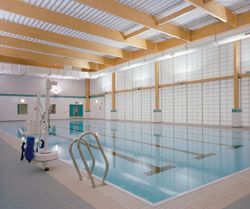Anyone involved in the design of sustainable schools needs to take account of a wide range of different factors and guidelines. Ant Wilson and Katie Marsden of AECOM highlight some of the key issues.
Education continues to be an important sector for the building services industry. This is partly because of the work it generates for consultants, contractors and suppliers but just as important is the potential to achieve a high level of sustainability in a major portion of the UK's building stock.
In the latter respect, it's important to remember that a sustainable school is one that works efficiently and with minimum environmental impact in 50 years time. We're not in the business of building schools that will have to be replaced in 10 years time - and that means today's designs need to take account of predicted developments, rather than being based on design criteria that were developed 20 years ago. Such developments include potential changes in the usage of schools and the structure of the school day, and school year - as well as the 'headline' issue of climate change.

Ant Wilson
Clearly, then, building services designers have to take account of all of these factors and there are a number of initiatives that will help with the decision making process. Not least of these is the BREEAM Education certification that was introduced in 2005, driven by the Sustainable Development Action Plan, and called for new build and refurbished schools to achieve no less than a 'Very Good' rating.
A revised version of BREEAM Education in 2008 has tightened these requirements even further. Whereas it was originally possible to gain BREEAM certification by focusing on just some of the key areas, there are now mandatory criteria that necessitate a more holistic approach.
From a building services perspective, the most obvious of these is that energy now accounts for 19 per cent of the BREEAM points and for a school to achieve BREEAM Excellent it must also achieve an Energy Performance Certificate rating of 40 - equivalent to a B. This means passive measures need to be introduced in the very early design stages to ensure maximum energy efficiency. There may also be increased scope for renewable energy sources, particularly in the light of the recently introduced feed-in tariffs, and this will be discussed later.

Katie Marsden
In addition to energy considerations, of course, there are also BREEAM points for rainwater harvesting, greywater recycling and general efficient use of water in the building. At the same time, transport plans that encourage pupils, staff and users from the local community to avoid car journeys - again earning BREEAM points - may create a demand for more showering facilities.
In fact, while BREEAM continues to be a voluntary requirement in principle, in practice many local authorities are adopting BREEAM as a compulsory standard - and generally requiring an 'Excellent' rating to obtain planning consent.
Back to the future
As noted above, any such design will need to account for changes in the future and one of these is clearly climate change with higher ambient temperatures. Given that many classrooms already become overheated in the summer this is potentially a major problem for schools of the future.
To address this, an initiative by Partnership for Schools is currently looking at how new and existing schools can be adapted to tackle overheating without resorting to air conditioning.
Making use of the latest figures from the UK Climate Impacts Programme (UK-CIP), this initiative considers primary and secondary schools of different ages and advises on measures for adaptation. Here, the emphasis is on passive measures such as opening windows and using solar shading rather than resorting to mechanical methods.
There is also an emphasis on ensuring that when such measures are fitted, or retrofitted, all relevant people are made aware of how to use them to full effect.
In fact, overheating of classrooms is a major challenge and is also dealt with in Building Bulletin 101, which includes two relatively simple software programs, Classvent and Classcool. However, it's important to emphasise that these are relatively simple tools, and that the criteria for measuring comfort have been continually evolving. Consequently, there is a need for designers to address this issue in more detail, and not rely solely on such tools if they are to avoid overheating in the future.
In this respect, it's interesting to note that post-occupancy evaluations by BSRIA indicate that some older Victorian schools are less likely to overheat than more modern structures. This is partly because of higher ceilings and the likelihood that they are single-glazed which allows the heat out, and possibly because of the higher thermal mass.
However, thermal mass can be misleading and it's important to consider the way a classroom will be used everyday, rather than basing design on an empty space. This issue has been highlighted by recent studies carried out within the remit of the Target Zero (
www.targetzero.info) initiative, sponsored by the British Constructional Steelwork Association and Corus.

Schools are more integral to the local community
These results showed there is considerably less difference in thermal variation between concrete and steel frame schools than was previously thought.
The Target Zero initiative is designed to provide guidance on designing zero-carbon buildings in five main sectors - though it's worth noting that zero-carbon for non-domestic buildings hasn't yet been officially defined. Nevertheless, the initiative provides very useful information because it takes account of embodied carbon as well as the performance of the buildings.
The first Target Zero report to be published focuses on the schools sector and it makes a number of interesting points. Not least of these is its conclusion that the most cost-effective route to true zero-carbon operation is to use a combination of on-site energy efficiency measures along with off-site and on-site low or zero carbon (LZC) technologies. It also notes, based on the recently constructed Christ the King Centre for Learning secondary school in Merseyside, that the steel composite structure had a 14 per cent lower embodied energy content than the alternative in-situ reinforced concrete flat slab structure.
Changing face of renewables
As with just about every sustainable project, it's important to consider LZC technologies in general, and renewable energy sources in particular. In this respect, the recently introduced feed-in tariffs have dramatically changed the return on investment scenario. Suddenly photovoltaics (PVs) and wind turbines are now much more viable and this sea changes needs to inform the building services engineers' decision-making process. For example, if a large area of roof is available for capturing solar energy, will it be more cost effective to install PVs for power generation, or is there a large base heating load such as a swimming pool that will make solar thermal more viable?
Nor is it just the face of renewables that's changing. Schools are now becoming a much more integral part of their local community, making swimming pools, sports halls, theatre facilities, classrooms and much more available to local people.
Similarly, some authorities are now combining more educational facilities on a single site. The result is that it no longer makes sense to base design decisions on a relatively small site with usage restricted to 8.30am to 4.00pm, five days a week, 40 weeks a year.
In adopting low carbon designs there is also more potential to gain funding through the Building Schools for the Future and Primary Capital programmes. In addition, where a design can be shown to be at least 60 per cent better than the Building Regulations Part L 2002 there is additional funding available for LZC technologies.
All of which means that building services engineers need to adopt a much wider view on school projects, taking account of not just the engineering issues but also financial aspects such as feed-in tariffs and funding opportunities. We may also consider how the building's design can be used as an educational tool to promote sustainability awareness.
Of course, there will always be some who think of these aspects as a distraction from the core role but we believe this is a great opportunity for building services to raise its game, its profile and its influence.
Ant Wilson is director of the Sustainable Development Group of AECOM and a low carbon consultant. Katie Marsden is a consultant in the Sustainable Development Group of AECOM and is a BREEAM AP